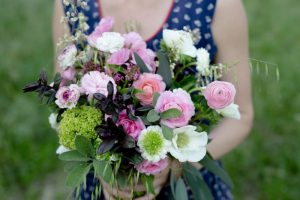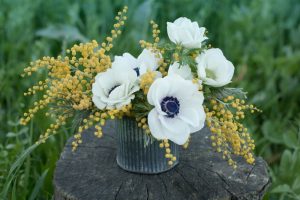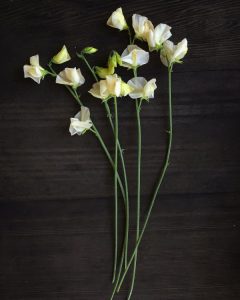Spring flowers are some of the most exquisite garden additions: fragrant sweet peas exploding over a fence, snow-white anemones with nautical blue button eyes, swollen green poppy pods and fresh greens. Spring, however, always feels like the most ephemeral of the seasons. This makes it hard for a lot of us growers to appropriately time when to plant spring flowers. The best method I’ve found to address this is to actually plant your hardy annual spring flowers in the fall. This will provide robust, bountiful blooms the following spring and extend their growing season.
I spent a few frustrated years missing the mark because I sowed my seeds just as the ground began to thaw, and then waited and waited for the soil to dry out enough to get my transplants in the ground. By the time the ground was finally ready, the plants had overgrown their trays – getting root-bound, requiring supplemental fertility, and threatening to bloom quite prematurely.
And then, once the plants were finally in the ground, they grew and flowered, but were never very prolific or robust. As soon as the heat hit, which could begin in June, they were on their way out. I started to realize that if I wanted to have great flowers in spring, I couldn’t wait until spring to plant them! My best annual spring flowers were always a huge patch of Ammi visnaga (or False Queen Anne’s Lace) that I let self-seed every year, and another self-seeding patch of sweet peas. They began blooming while the ground was still drying out in May, a sure sign that the seeds had dropped to the ground the previous fall, germinated, and started to grow a strong plant that withstood our rainy, cold winter.

Such is the lifespan of hardy annual spring flowers. This class of flowers can take extremely cold temperatures (some even need that cold period to excel), and will flower their heads off the following spring. Lucky for me, the queen of the hardy annual, Lisa Mason Ziegler of the Gardener’s Workshop Farm in Virginia, came out with a great book about this topic just as I needed it. Cool Flowers details all of our favorite hardy annual or ‘cool’ flowers, how to grow them, and how to observe the natural cycles of your climate and mimic what’s going on with plant life.
The key to growing annual spring flowers is timing. Sow your flowers about 6 – 8 weeks before your expected first frost date in trays or directly in the ground (depending on the variety – check out Lisa’s book or your seed packet for more info). Prep your soil well for a long winter, get your plants in the ground, and then watch them grow. Keep weeds at bay the best you can and trust that these plants will make it through even the most severe winter. They may shrivel up, brown, or even look dead, but really their root systems are developing underground and will provide ample returns in spring with large, robust plants.
Here are some of my favorite annual spring flowers to sow in the fall.
Annual Spring Flowers: Anemones

I fall more deeply in love with anemones every year. This year was the first time that I had a great crop of them, and I truly attribute the success to the fact that I got them in the ground early enough last fall (in 2014 I remember frantically planting them on Thanksgiving morning as I rushed to get out of town to celebrate. Too late!).
They do better with a little extra love. This past year I both pre-chilled and pre-sprouted mine, two tasks that helped to jumpstart their growth right before winter’s chill came on. I’m going to share with you guys my favorite article on growing anemones written by one of my favorite flower people out there -Jennie Love of Love n Fresh Flowers in Pennsylvania. Her zone gets a bit colder than ours, and depending on your microclimate you can probably grow your anemones without the help of a low tunnel greenhouse. I’ve done both and had success.
Annual Spring Flowers: Sweet Peas
Sweet peas seem to be many gardeners’ gateway flower. Once you grow them with some success, experience their fragrance and get fresh flowers to bring into the house every week, you start to wonder what else is out there.

I’ve grown sweet peas successfully by sowing them in the spring, but have gotten far better results by sowing them in the fall, either in trays in the greenhouse (preferred) or directly in the ground. A few tips on sweet peas: they do better when allowed to develop deep roots, so sow them in deep trays. As they’re growing on in the garden they need a lot of water, and often. Train them up a trellis or some netting, and tie them up toward the netting every foot or so. They’ll keep flowering through a good part of the early summer. Some great sources for sweet peas are Floret Seeds, Owl’s Acre in England, and Enchanting Sweet Peas right here in Sebastopol.
And finally, here’s a great article on growing sweet peas from Erin of Floret, a self-professed die hard sweet pea addict.
Annual Spring Flowers: Foxglove
This magnificent flower is actually pretty versatile. I have some starting to bloom now that I got in the ground in June, and while I’m excited to have fall foxglove blooms, if you sow them in fall for spring blooms the plants will be about three times bigger and most robust. This is turn creates bigger, more impressive flowers.

Foxglove flowers are interesting in that they’re actually a biennial, meaning they’ll bloom in the second year, but there are some varieties that bloom in the first year. Whichever one you’re working with, should plant it in the fall and reap the rewards of striking tall blooms next spring. I highly recommend ‘Dalmation Peach’ (a “FYF” or first year flowering variety), or “Apricot Beauty” (a true biennial). Get ready to be stunned.
In addition to the flowers we’ve detailed in this post, I highly recommend planting larkspur, nigella, bells of Ireland, scabiosa, and snap dragons the same way.
Get started now! Here in Sonoma County we’re closing in on the last days to be able to sow annual seeds for big blooms next spring using this method. So get ye to the Seed Bank, and get growing!







 Family
Family

